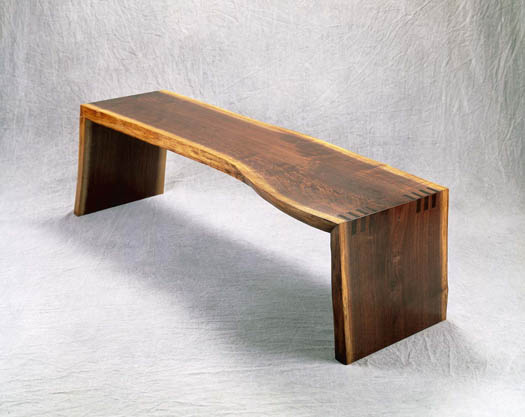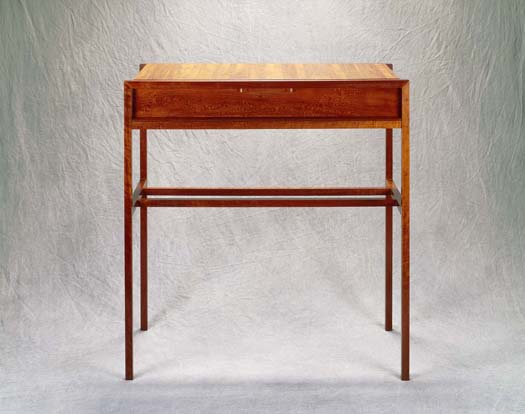
With a portfolio that would take your breath away, Geoffrey Noden is the kind of guy that engenders both intense admiration and a good dose of jealousy. It’s impossible to look at the quality of his work and not be totally awed by it. The trouble is that it’s so good, he just about makes me want to hang up my chisels.
A forty-four-year old single parent raising his four year old daughter, Noden runs a shop in his home town of Trenton, NJ. For the past two decades, he has taught, invented tools, and designed and built some of the finest furniture you’ll find anywhere in this fair country.
“All I’ve ever done is what I’m doing designing and making furniture,” Geoff told me. Apparently, he started early. “I took all the woodshop courses I could in high school. As a senior, I made a grandfather clock. I was often in the woodshop three times a day, instead of just once.”
But his trail to woodworking excellence was not quite as seamless as it seems. Not long after high school, he and his brother moved to England to work at Hornes of London, a clothier owned by members of his extended family. That didn’t last long. He soon applied to the prestigious John Makepeace School of Woodworking in Dorsett, England, but at first, was not accepted.
Undaunted, he went back to the U.S. and spent the next year and a half paying for an apprenticeship in what was, sadly, a less than top quality woodshop. At the same time, he created his own shop in the basement of his house, where he attempted to raise the bar on his woodworking skills.It was enough to get him over the hump, and when he once again tried for the Makepeace school, he was accepted. In fact, he was the first American ever enrolled there.
The two-year school, set in the English countryside, took only nine students per year, drawn from all over the world. Geoff credits it with offering him a rich and varied social life as well as a solid woodworking education.
“Our first year, we were taught how to work wood. Obviously, you need to learn about the material before you can think about designing with it.” Most of the projects relied heavily on hand tools, an approach that Noden firmly supports. “I certainly don’t eschew the use of power tools, but your work will never be as good as it can be if you are not able to use hand tools.”
The second year emphasized design. “That’s where I learned the value of making models and mock-ups,” an activity that helps both him and his customers visualize the piece. He still remembers one teacher at the school pointing out that the typical English farm cart is the ideal of perfect design, because it is fashioned by the person intending to use it; the farmer. That awareness shows up in Noden’s designs as well.
After school, he moved back to the U.S. and returned to the shop in which he had apprenticed, but soon became disenchanted with both the quality of work and teaching being turned out. At 25, he left to set up his own shop, and immediately advertised for students. That’s not as surprising as it seems. He enjoys teaching both children and adults as much as working wood, and still does both to this day.
In addition to commissions that came in, the shop made Geoff’s pieces, designed in part to incorporate woodworking techniques he felt were worth learning. As a result, the shop was productive while providing a thorough teaching experience.
Noden avoids built-ins, preferring chairs, tables, and free-standing cabinets, mostly for a high-end market. However, his designs span many styles, ranging from his rustic “Shaved Chair” to the elegant “Arch Top Chair.” The Arch Top Chair, which sells for a cool six thousand dollars, earned him the title of “Best New Artist in Wood” at the 1997 Philadelphia Furniture Show, and later appeared on the front cover of Taunton’s Design Book Seven.
Not content to do the job part-way, Geoff starts from scratch. He mills his own wood, including sawn veneer, from logs he gets from local tree cutters. This allows him to use air dried wood, but means he often has to plan two or three years in advance to account for drying time. The wood gets finished off in a homemade kiln fired by the excess heat from the wood stove heating his shop.
Milling wood allows him to get consistent color and appearance, because he can make a piece of furniture using wood that all came from one log. Not surprisingly, he also has been known to design and make his own brass hinges. “After putting in all that effort, it doesn’t make sense to outfit your best work with store-bought hardware.”

His need for a bench that changes height for various jobs resulted in his designing an adjustable bench some fifteen years ago. Originally made of wood and mild steel shaped with a hacksaw, it eventually evolved into a patent for his “Adjust-a-bench.” A pair of nesting steel trays makes up each leg, in which one tray slides up and down inside the other.
A spring-loaded foot pedal releases a latch on a ratcheted assembly. Lifting slightly on the benchtop unhooks the latch, a safety feature that prevents the bench from accidentally slamming down when you step on the foot pedal. In the closed position, the weight of the benchtop itself locks the ratchet with a gravity clamp. Not only does the height change easily, but by setting different heights at each end, you can create an angled benchtop, a format perfect for certain applications.
His patent for a wafer cutter came about while working on a ten-chair order. Each chair has 180 pieces of end grain wafers in its circular inlay. The cutter will chop and shape them to any configuration accurately and quickly. He uses epoxy to set the inlay, because a water based adhesive would swell the wafers to the point where they would no longer work.
When I asked this talented designer, inventor, teacher, and master woodworker what advice he would offer others, he said simply “Keep doing woodwork. It brings everyone pleasure, and you can’t get enough of that.”





